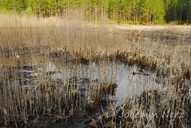|
Siren lacertina Österdam, 1766
Greater Siren | family: Sirenidae genus: Siren |
 © 2016 Dr. Joachim Nerz (1 of 21) |
|
|
|
Description Adult coloration varies from olive green to light gray above and sometimes there are dark spots on the head, back and sides. The sides are lighter colored than the dorsum and usually have flecks of pale green. The venter is bluish grey and often has pale green flecks. Description from Petranka (1998). Juveniles have light, often yellow, body stripes that fade with age (Martof 1973; Petranka 1998). Distribution and Habitat Country distribution from AmphibiaWeb's database: United States U.S. state distribution from AmphibiaWeb's database: Alabama, Florida, Georgia, North Carolina, South Carolina, Texas, Virginia
Greater sirens inhabit a variety of permanent and semi-permanent aquatic habitats, including ditches canals, marshes, rice fields, lakes, and slow-moving streams and rivers (Petranka 1998). Sites are often muddy or heavily vegetated. Young are often found among water hyacinth roots (Martof 1973) Life History, Abundance, Activity, and Special Behaviors Greater sirens eat a range of prey items, including a high proportion of molluscs (snails and freshwater clams). Animals are active primarily at night and retreat to burrows during the day. When temporary pools of water dry up, sirens will aestivate underground and can easily survive for months. Greater sirens vocalize using clicks and yelps, as do lesser sirens. These sounds are produced when animals are disturbed and also may serve for intraspecific communication. Greater sirens are locally abundant in Florida, Georgia, and eastern South Carolina. See Petranka (1998) and references therein. Despite their large size and abundance in some regions, relatively little is known about the biology and ecology of greater sirens. Trends and Threats Comments
References
Flores-Villela, O., and Brandon, R.A. (1992). ''Siren lacertina (Amphibia: Caudata) in northeastern Mexico and southern Texas.'' Annals of Carnegie Museum, 61, 289-291. Martof, B. S. (1973). ''Siren lacertina Linneaus. Greater Siren.'' Catalogue of American Amphibians and Reptiles. Society for the Study of Amphibians and Reptiles, 128.1-128.2. Martof, B. S. (1974). ''Siren Linnaeus. Sirens.'' Catalogue of American Amphibians and Reptiles. Society for the Study of Amphibians and Reptiles, 152.1-152.2. Martof, B. S. (1974). ''Sirenidae. Sirens.'' Catalogue of American Amphibians and Reptiles. Society for the Study of Amphibians and Reptiles, 151.1-151.2. Petranka, J. W. (1998). Salamanders of the United States and Canada. Smithsonian Institution Press, Washington D.C. and London. Sever, D. M., Rania, L. C. and Krenz, J. D. (1996). ''Reproduction of the salamander Siren intermedia Le Conte with especial reference to oviducal anatomy and mode of fertilization.'' Journal of Morphology, 227, 335-348. Originally submitted by: Meredith J. Mahoney (first posted 2000-07-16) Edited by: M. J. Mahoney (2001-06-04) Species Account Citation: AmphibiaWeb 2001 Siren lacertina: Greater Siren <https://amphibiaweb.org/species/4316> University of California, Berkeley, CA, USA. Accessed May 15, 2025.
Feedback or comments about this page.
Citation: AmphibiaWeb. 2025. <https://amphibiaweb.org> University of California, Berkeley, CA, USA. Accessed 15 May 2025. AmphibiaWeb's policy on data use. |




 Raffaëlli Account
Raffaëlli Account Map of Life
Map of Life